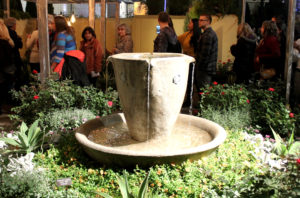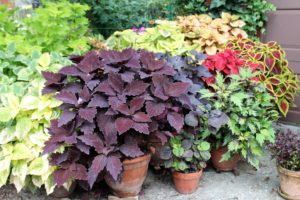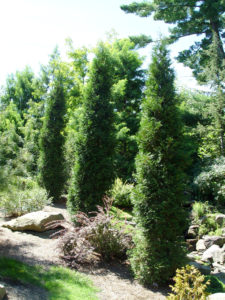Mediterranean Gardens for Pennsylvania
March 3rd, 2020
This week’s 2020 Philadelphia Flower Show is showcasing plants and gardening of the Mediterranean – especially the gardens of southern France, Monaco, northwestern Italy, and a touch of Spain.

Here’s a classic Mediterranean-style garden, complete with stone and the Mediterranean signature plant, lavender.
This is a colorful, fragrant, and highly textural form of gardening that I think a lot of Pennsylvanians would like… if we didn’t have that little problem of freezing winters to deal with.
Mediterranean climates are distinctive for their year-round warm temperatures and very dry summers. So the look is different from what you see in warm but wetter tropical/subtropical regions such as Florida, the Caribbean, and parts of central America.
Although we can’t do a real Mediterranean garden with olive and citrus trees, agaves, and arrow-like Italian cypresses, we can create Mediterranean-like gardens.
Let’s have a look at some key features of the Mediterranean style and how we can shift gears a bit to make it happen here.
Pots
Here’s an easy one. Mediterranean gardens often feature pots or pot groupings filled with specimen plants and colorful flowers.
Terra-cotta, stone, and/or ceramic pots are right at home, and we can do those as well as Riviera gardeners.
Succulents and dwarf conifers are great choices since they’ll all do fine in our hot summers and tolerate a few days if we forget to water the pots (or can’t).
Hardy succulents and most conifers can overwinter in stone or concrete pots outside.
Tender succulents will have to go inside as houseplants for winter or be bought new each spring.
Terra-cotta and ceramic pots will crack outside in winter, so store them in a dry garage or shed in winter.
Hardy plants in crackable pots can be planted in the ground for winter and returned to the pots in spring.
You could also grow those Mediterranean olives, lemons, oranges, figs, agaves, palms, cycads, and other favorites in pots if you’re willing to move them inside in winter. This is where a greenhouse or sunroom pays off.
Textural plants
A lot of Mediterranean plants have strong forms and distinctive textures. Think the lacy leaves of santolina, rosemary, and lavender, the spiky forms of aloes and euphorbias, and the garden “exclamation points” of tall, skinny Italian cypresses.
Some of those are hardy to our Zone 6, in particular the Mediterranean signature plant of lavender. Just be sure you give lavender superb drainage, or it’ll rot out over winter.
We can also substitute cold-hardy alternatives to mimic the look of a Mediterranean garden.
Narrow arborvitae, such as ‘Degroot’s Spire,’ North Pole and Thin Man, or the columnar juniper ‘Skyrocket,’ or the skinny upright boxwood ‘Dee Runk’ would be excellent form substitutes for those too-tender Italian cypress.
Bald cypress (Taxodium distichum) gives you a similar foliage texture on a species that’s much winter-hardier, although also wider than Italian cypress.
Yucca is a strappy/pointy upright that’s a good substitute for agave.
Ornamental grasses are good, winter-hardy choices for spiky, textural uprights.
And hardy orange (Poncirus trifoliata) is a cold-hardy small tree that produces fruits that are dead ringers for oranges, although inedibly bitter. Be aware that the tree also has stiff, sharp needles.
For a small flowering tree, check out hardy crape myrtles such as Dynamite, Red Rocket, ‘Hopi,’ ‘Natchez,’ ‘Sarah’s Favorite,’ and Pink Velour.
Four good broadleaf evergreens are cherry laurel, nandina, boxwood, and sweetbox.
And shrub roses are another natural in a Mediterranean setting that we can easily grow.
Silver plants
One way plants cope with extraordinarily dry Mediterranean summers is to grow little hairs or waxy coatings on their leaves to cool their surface and reduce evaporation/transpiration loss.
That often results in leaves that are silvery or blue.
We can do many silvery/blue perennials, including catmint, Russian sage, lavender, silver thyme, artemisia, santolina, silver-leafed brunneras like ‘Sea Heart,’ ‘Silver Heart,’ and ‘Jack Frost,’ and some salvias.
Blue fescue, little bluestem, and blue versions of switchgrass (i.e. ‘Dallas Blues’ and ‘Heavy Metal’) give you double winners with spiky texture and blue foliage.
The creeping junipers ‘Blue Pacific’ and ‘Silver Mist’ are two good silver-needled, hardy evergreens, and bayberry and caryopteris are two good silvery flowering shrubs that would look at home in a Mediterranean-style garden.
We can also beef up or spot a Mediterranean-like garden with silvery annuals, especially dusty miller, senecio, dichondra ‘Silver Falls,’ licorice vine, and silver sage.
Geraniums, white euphorbia, and annual blue salvia also will look at home, although they’re not silver-leafed.
Rock and stone
Plentiful rock from the cliffs and mountainsides explain why rock and stone is such a common element of Mediterranean gardens.
If you lean more formal, go with manufactured stone pavers for walls and paths.
If you lean natural, go with boulder accents, dry-laid stone walls, and/or gravel or stonedust paths.
Water
Because the climate is so dry, many Mediterranean gardens have ponds or fountains to add a little counteracting coolness.

Most Mediterranean-style gardens have some sort of water feature. Here’s an elaborate cup fountain on display at the 2020 Philadelphia Flower Show.
It could be something as simple as a container water garden in a stone trough.
Or you could go a bit more elaborate with a fountain or go all the way with a bigger pond with waterfall or a formal water feature.
Ornaments
Finish off your Mediterranean look with at least one or two focal points.
Concrete statuary would be a natural, but you could use anything that suits your taste (gazing globe, bee skep, a “found” object, etc.)
Even an ornate pot or urn (planted or unplanted) can serve as a signature centerpiece.
Be sure to improve the soil so your drainage is excellent. Slightly raised beds with gravel as mulch (instead of bark) not only looks more “Mediterraeny” but will keep those plant roots from rotting in our lousy clay.










